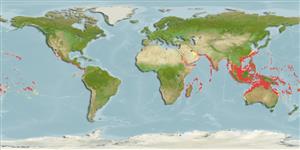Preferred temperature (Ref.
115969): 24.3 - 28.8, mean 27.6 (based on 898 cells).
Phylogenetic diversity index (Ref.
82804): PD
50 = 1.0000 [Uniqueness, from 0.5 = low to 2.0 = high].
Bayesian length-weight: a=0.00339 (0.00200 - 0.00575), b=3.13 (2.99 - 3.27), in cm Total Length, based on LWR estimates for this species & (Sub)family-body (Ref.
93245).
营养阶层 (Ref.
69278): 4.2 ±0.6 se; based on diet studies.
回复力 (Ref.
120179): 非常低的, 最小族群倍增时间超过14 年 (tm=5-9; tmax=25; Fec=1).
Fishing Vulnerability (Ref.
59153): Very high vulnerability (90 of 100).
